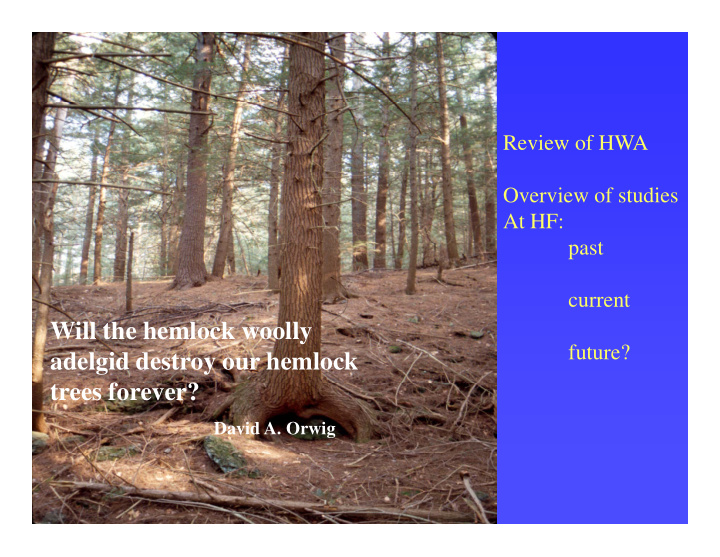



Review of HWA Overview of studies At HF: past t current Will the hemlock woolly future? adelgid destroy our hemlock trees forever? f ? David A. Orwig
Kathy Shields USDA Forest Service Hemlock woolly adelgid ( Adelges tsugae ) 2 generations /year Parthenogenetic rapid dispersal feed and kill all sizes and ages hemlock resistance? No effective native predators
HWA life cycle in E. North America (USDA)
Nathan Havill, Yale University Adelges tsugae documented on all 9 hemlocks worldwide Adelges tsugae documented on all 9 hemlocks worldwide Recent genetics: from So. and low elevations in Japan Serious pest only in Eastern U.S.
Harvard Forest HWA studies include: Study Sites Study Sites 1) Stand and community analyses 2) ) Landscape investigations p g of hemlock structure and HWA infestation patterns 3) ) Ecosystem analyses of y y HWA infestations including n cycling, decomp, throughfall chemistry 4) Comparisons of HWA vs. Hemlock Logging 5) Wildlife studies Figure 1. HWA space-for-time study area, representing 7500 km 2 . 6) Hydrological Hemlock represents >86,000 ha or 21% of the mapped area in MA Investigations g (up to 36% in northern MA), and 16,500 ha or ~5% of the mapped area of CT. 7) HWA dispersal
Hemlock Overstory Mortality 100 100 90 80 ity 70 nt Mortal 60 1995 50 2005 Percen 40 2008 30 20 10 0 BB BB CP CP G G SC SC RH RH FP FP TM TM SR SR DH DH Sun Sun WH WH Study Site O Overstory mortality trends, high in many, but not all stands t t lit t d hi h i b t t ll t d
Crowns continue to deteriorate, with no sign of recovery
Rapid birch establishment Occurs with canopy thinning
Invasives and ferns can also increase tremendously
LANDSCAPE PATTERNS CT: 114 stands MA: 123 stands HWA found within a few km of Vermont! Latitudinal pattern present But damage not as rapid Only 2 stands > 50% Overstory mortality in MA
Ecosystem Results HWA leads to many indirect effects including dramatic structural and compositional changes, leading to: higher soil temperatures and p g , g g p subsurface soil moisture content, and reduced forest floor soil moisture content Resin bags incubated in soils captured higher amounts of ammonium Resin bags incubated in soils captured higher amounts of ammonium and nitrate in infested versus control hemlock stands, indicating greater N availability.
HWA continues to migrate and cause decline and mortality in and mortality in New England and elsewhere Salvage and pre- salvage is commonly associated with HWA associated with HWA infestations; more knowledge is needed t to inform managers i f and landowners
R. Ebener High Intensity cutting, but Little to no soil scarification, and no slash d l h (public safety, aesthetics, erosion control) R. Ebener Arnold Arboretum’s Hemlock Hill 1/05
Logging sites Had higher Had higher Seedlings and Saplings than HWA i f HWA infested t d Or control sites
Discussion Discussion • HWA infestation and logging impact the structure in diff different ways due to inherent differences in the mode of t d t i h t diff i th d f disturbance • Decline from HWA is gradual and exhibits variation within and among stands creating variable vegetation responses; more snags responses; more snags • In contrast, logging leads to abrupt overstory removal and rapid vegetation recovery across the harvested area d id t ti th h t d (more slash, scarification)
ARBORjet Imidacloprid (Merit) pesticide of choice: Tree I.V. Kioritz soil injection j Photo: David Foster Soil drench Stem injection-important near streams So, what can , CoreTect time release tablet CoreTect time-release tablet be done? often provides 2 to 4+ years protection
Soil application widely used
Biological Controls From Japan, over 1.5 million have been Released in over 100 sites in 15 E Eastern sites including MA t it i l di MA Carol Cheah Sasajiscymnus tsugae Native to British Columbia, over 7000 Adults have been released at 19 sites Ad lt h b l d t 19 it In 8 eastern states-recovery 2 years later Others are on the way: Scymnus sinuanodulus Tetraphleps galchanoides Tetraphleps galchanoides Pathogenic fungi USDA Laricobius nigrinus Uncertain success, impact
So what can students do to add to this body of work? Can provide year by year assessments of HWA densities p y y y Can evaluate year to year branch growth, related to HWA Can provide important data at the northern extent of HWA range
A co occurring pest on the rise! Students can also contribute here A co-occurring pest on the rise! Students can also contribute here Elongate Hemlock Scale (EHS; Fiorinia externa ) (EHS; Fiorinia externa ) Also from Japan, introduced in NYC in 1908 NYC in 1908 Now located in 14 eastern states, range overlaps with HWA Often co-occur with HWA on same Often co occur with HWA on same tree: uncertain consequences
Facilitation by HWA??
Southern Appalachian forests dying rapidly! W. Blozan
Recommend
More recommend